Razm.info has tried to analyze the participation of the Turkish Armed Forces in the hostilities in Artsakh since September 27. Our first article on this topic, “Turkey’s participation in the war ” Part 1: F-16s ” was about the possible use of F-16 fighters of the Turkish Air Force. In “Part 2”, we discuss the use of Bayraktar TB2 UAVs.
From the very beginning of the war that started on 27 September, the Azerbaijani side actively used Bayraktar TB2 combat UAVs. Unlike other drones in the arsenal of Azerbaijan, which were used during the April war in 2016 and the hostilities in July 2020, these drones were being used for the first time. Before that, alongside the reconnaissance drones, Azerbaijan had and used Israeli-made Harop, Orbiter 1K, Skystriker (“kamikaze”) UAVs. They all explode when approaching the target, meaning they are of single use.
Bayraktar TB2 is a combat drone. It carries a total of 4 MAM-L and/or MAM-C laser-guided missiles produced by the Turkish company “Roketsan” and returns to the base after completing the task. In addition to launching its own missiles, it can also direct laser-guided missiles and bombs fired from other land or air platforms.
Tactical and technical specifications of Bayraktar TB2 UAV:
Operating radius: 150 km
Maximum flight weight: 650 kg
Payload: 150 kg
Maximum speed: 222 km/h
Endurance: maximum 24 hours
Wingspan: 12 m
Length: 6.5 m
We know that during the war, Bayraktar UAVs were deployed at various air bases in Azerbaijan to secure them from missile strikes by the Armenian side and to reduce the damage “on the ground” as much as possible.
First from the known bases is the Dallar air base, located about 6 km north-west of the city of Shamkhor. Azerbaijan inherited the base from the Soviet era, however in 2020, particularly during summer, the base was completely reconstructed, modernized, and technically equipped. It is noteworthy that during the war, on 2 October, the Ministry of Defense of Azerbaijan announced that the Armenian side had launched a rocket attack on the village of Sabirkend in the Shamkhor region. The village is located right next to the Dallar military base, about 600 meters from the runway.

Bayraktar TB2 UAV in Yevlakh: the photo was published on 22 October.
It is apparent from the satellite photos taken during the war that Bayraktar TB2 UAV was located in another UAV center of the Azerbaijani Armed Forces, which is located near the Yevlakh airport. The photo shows 1 Bayraktar TB2 in front of the UAV hangar and a Hermes 900 UAV next to it.
In another satellite image taken on 10 October, two Bayraktar TB2 UAVs were seen in the western side of the Kurdamir Air Base in central Azerbaijan. Kurdamir AB is the center of Close air support (CAS) aviation of the Azerbaijani Air Force: SU-25 jets were flying from here during the war. As already mentioned earlier, in addition to launching their own missiles, Bayraktar TB2 UAVs also directed laser-guided missiles and bombs fired from other platforms to the target.
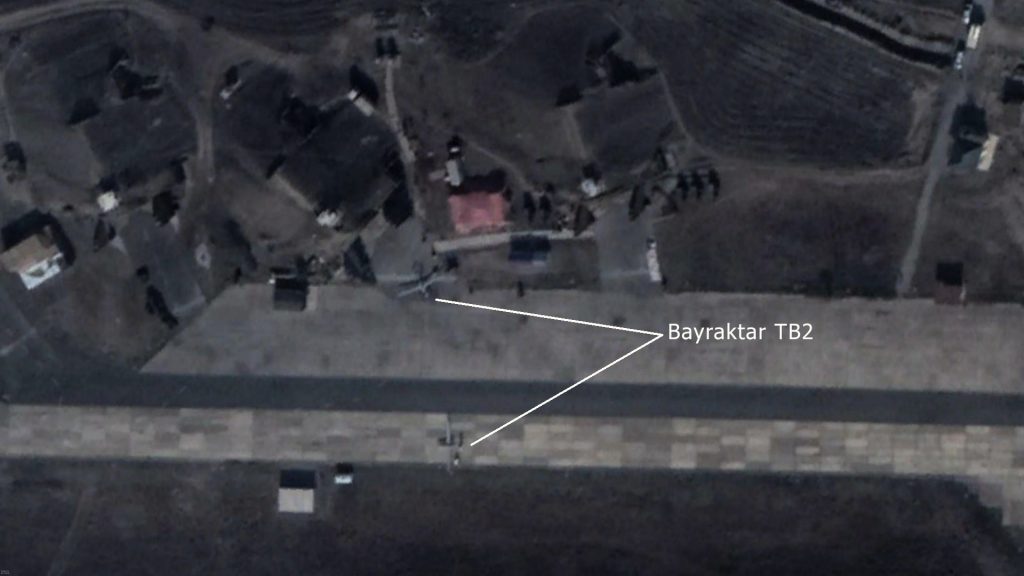
Two Bayraktar TB2 UAVs at Kurdamir air base, 10 October
As for the SU-25s and laser-guided aerial bombs, the Azerbaijani side was directing aerial bombs through Bayraktar TB2 UAVs during the war. Azerbaijan installed LGK (laser-guided kit) made by the Turkish company Aselsan on its own QFAB-250 air bombs, making them laser-guided. Azerbaijan demonstrated this bomb during the ADEX 2018 Defence Exhibition held in Baku in September 2018.
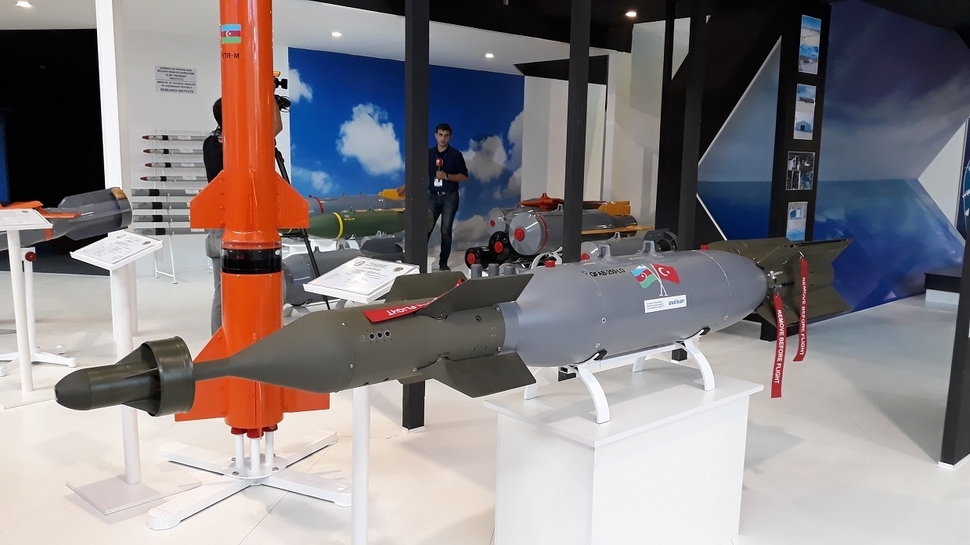
QFAB-250 laser-guided air bomb, ADEX-2018
A video spread on social media, showing the Azerbaijani side launching a MLRS (Multiple Launch Rocket System) missile during the war. The MLRS in the video was quite similar to the TRLG-230 missile system produced by the Turkish company Roketsan, which launches laser-guided missiles, and the Bayraktar TB2 directs them to the target.
These systems are relatively new, and even the Turkish Armed Forces do not have them yet. It is noteworthy that this system was tested in Turkey in August 2020, and the system was installed on a “Kamaz” truck. At that time, it was assumed that the tests on “Kamaz” could be for Azerbaijan, as other Turkish-made missile systems, like T-122 Sakarya, T-300 Kasrgha and its version with guided missiles ⁃ TRG-300, were mounted on “Kamaz” trucks in the Azerbaijani army. It can be noted that the Turkish side tested these missiles in real combat conditions during the war.

Shot from the launch of TRLG-230 in Azerbaijan.
However, the main question here is who controlled the Turkish-made UAVs during the war.
In this context, the history of acquisition of Bayraktar TB2 UAVs by Ukraine and the training timelines of their operators are useful. It can be a “measurement guideline” for comparing with the case of Azerbaijan, to understand whether Azerbaijani specialists could have the necessary time and experience to manage UAVs during the war.
On 19 November 2018, journalist Yuri Butusov was the first to give details about the purchase of Bayraktar TB2 UAVs by Ukraine. On 19 January 2019, Poroshenko, President of Ukraine at that time, officially confirmed the purchase, and about two months later, on 6 March, he announced that they had received the UAVs. At that time Ukraine received only a part of the ordered batch. 14 days later, on March 20, UAV was tested in Ukraine in the presence of Turkish specialists. Haluk Bayraktar, the CEO of the UAV manufacturer, was also present at the test.
On 4 September, the Ukrainian Defense Minister announced that the process of training the Ukrainian specialists by Turkey is underway, and the Ukrainian Air Force will be ready to operate the UAVs in the near future. That shows, that even 6 months after the delivery of the first batch, the Ukrainian Air Force was not yet fully ready to operate the received UAVs.
The first group of Ukrainian specialists completed the Bayraktar TB2 training course in Turkey on 27 September. A member of the group of 15 people from Ukraine gave some details to a Ukrainian news agency. She told that they spent 3 months in Turkey and were trained by Turkish specialists to operate UAVs in the air and on the ground, tested all the components of the system ” camera suspensions, munitions, etc. The last 3 of ordered UAVs were delivered to Ukraine in October 2019. More tests were conducted then with the direct participation of Turkish specialists.
The following can be highlighted from the experience of Ukraine:
• At least eight months after the delivery of UAVs, in October the Ukrainian Air Force was not yet ready to fully operate the UAVs on its own;
• The training course for Ukrainian specialists in Turkey lasted about 3 months, but after the training, Turkish specialists were still involved in Ukraine for tests and flights the following month.
As for Azerbaijan, it had interest in acquiring Bayraktar TB2 only since autumn 2018. During one of the conferences, Selchuk Bayraktar, the technical director of the Turkish company Baykar Makina, which manufactures UAVs, said in his speech that “negotiations with Azerbaijan on the acquisition of Bayraktar UAVs are underway.” From this statement of Bayraktar it could be concluded that there was an interest and no deal yet.
It should be noted that as of 2018, Turkey mainly used Bayraktar TB2 drones in operations against the Kurdish Workers’ Party (PKK), and at that time those UAVs did not have involvement in large-scale military operations, did not pass serious tests in combat conditions, and were not confronted by air defense.
Only in 2019 Turkey deployed the drones to Libya and, in fact, tested them during the ongoing civil war in the country, then since the end of February 2020, Bayraktar TB2s were involved in military operations against the Syrian government forces in the Syrian province of Idlib. In July 2020, during the Conference on Air and Space Power, the UK Secretary of Defense paid particular attention to Turkey’s experience, in particular the use of Bayraktar TB2 UAVs in Libya and Syria. It can be assumed that Azerbaijan’s interest in those UAVs practically grew only after they passed the test in military operations.
Discussions on acquisition of UAVs intensified in Azerbaijan in June 2020, when the Azerbaijani parliament ratified the Military Financial Cooperation Agreement, signed between Turkey and Azerbaijan on February 25 of the same year, which stipulated provision of USD 29.5 million to Azerbaijan for the period of 5 years for purchase of Turkish defense products. After the ratification, the Azeri government sources spoke about purchasing of military equipment from Turkey, including UAVs.
In June 2020, Azerbaijani Defense Minister Zakir Hasanov also spoke about the purchase of UAVs from Turkey. Referring to the above-mentioned Turkish-Azerbaijani agreement, he said that efforts were underway to purchase UAVs from Turkey. Although the Minister did not mention a specific UAV model, however, at that time the most probable option was Bayraktar TB2, as Azerbaijan already had a wide range of reconnaissance and suicide UAVs, and no combat drones. From the Minister’s statement it could be concluded that the drones were not yet delivered to Azerbaijan in June, but they were still working in that direction.
The next chronological event was the military operation in Tavush in July 2020, where Azerbaijan used its fleet of UAVs: they used both reconnaissance, including tactical Hermes-900, and suicide drones, Spike NLOS guided missiles, but use of Bayraktar TB2 UAVs was not registered. Theoretically, we cannot rule out the presumption that these UAVs were in the arsenal of Azerbaijan at that time, but they were simply not used. However, this version is unlikely, as it became clear from the fragments of at least one Bayraktar TB2 shot down during the war, that one of the key components of the drone, Canadian-made CMX-15D-SW EO/IR targeting and designating system was installed in September 2020, days before the war.
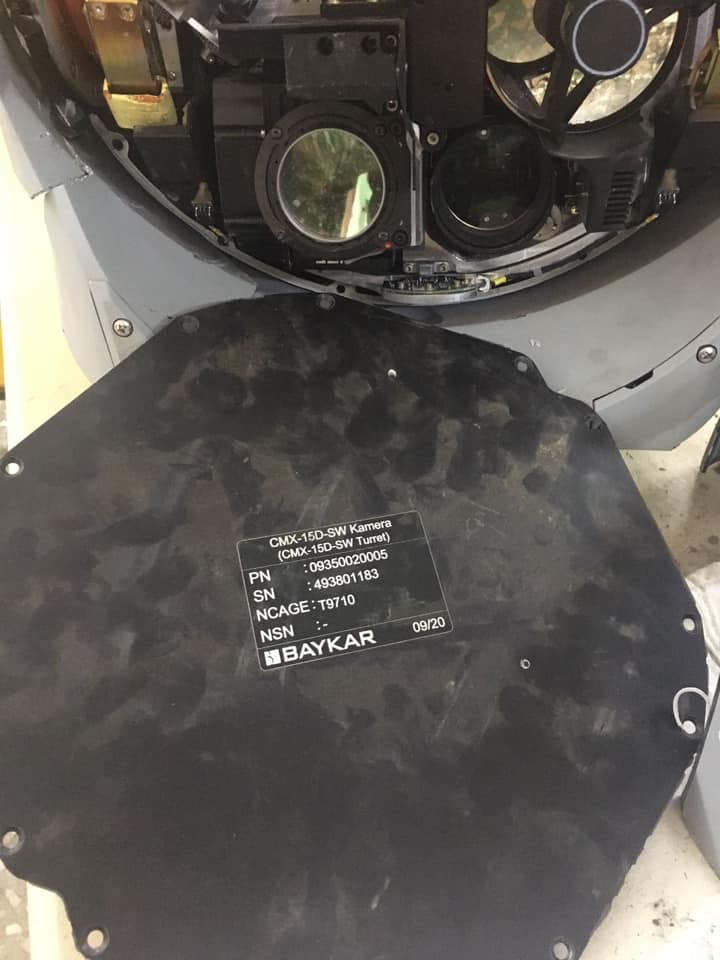
Fragments of the CMX-15D-SW after shooting down Bayraktar TB2.
As for the training of Azerbaijani specialists, they completed the training in Turkey on Bayraktar TB2 UAVs and got their certificates in early February 2021․ According to the Turkish news agency Hurriyet, 77 representatives of the Azerbaijani Armed Forces were trained on UAV operation and maintenance during the 4 months training course.
Judging from the training schedule for the Azerbaijanis, the specialists of their Armed Forces left for Turkey during the war, which significantly reduces the hypothetical possibility that Azerbaijani side was operating Bayraktar TB2 during the war. On the other hand, it is unlikely that another group of specialists from Azerbaijani Armed Forces was secretly trained in Turkey before the war, and then, receiving the UAVs in September, immediately took over the command of the drones during the war. As Ukraine’s experience shows, Azerbaijan did not have time for independent management.
Apart from the well-founded assumption and assertion that Azerbaijan could not operate UAVs on its own during the war and that Turkish specialists were involved, there are at least two circumstances that indicate the Turkish involvement.
The first fact is the presence of General Goksel Kahya in the delegation led by the Turkish Defense Minister who visited Azerbaijan in the summer before the war. Kahya is an officer in the Turkish Air Force, formally holding the position of a Deputy of the Deputy of the Turkish Minister of Defense (this is not a mistake, the position is called so), but he is known for coordinating Bayraktar TB2 UAVs in Libya along with other officers of the Turkish Armed Forces.
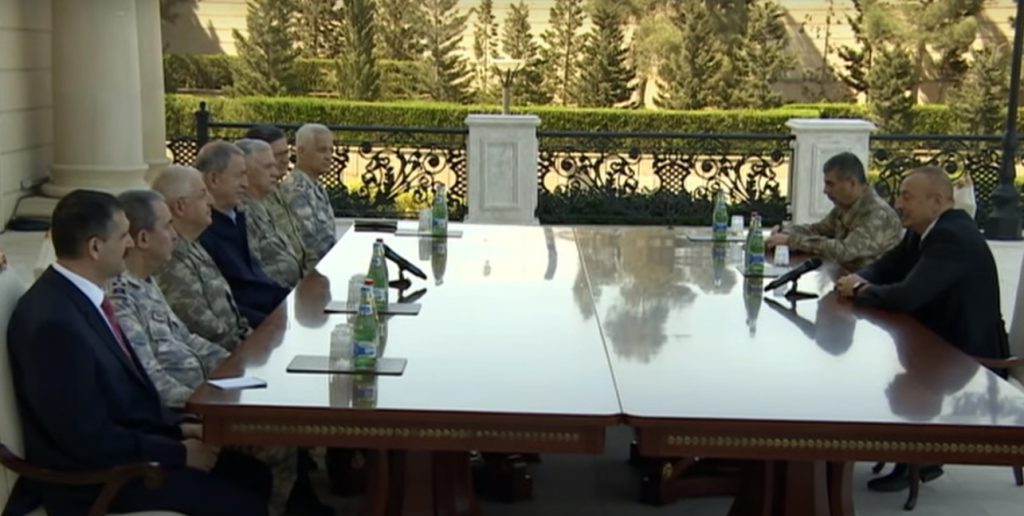
The delegation of the Turkish Armed Forces in Azerbaijan. Goksel Kahya is the last from the right, in a military uniform.
On 13 August, the President of Azerbaijan received the Turkish Defense Minister Hulusi Akar in Baku. Apart from Ilham Aliyev, Azerbaijani Defense Minister Zakir Hasanov was also present at the meeting. Turkish delegation included Turkish Ambassador to Azerbaijan Erkan Özoral, whose presence was for protocol, Chief of the General Staff Yaşar Güler, Commander of the Air Force General Hasan Küçükakyüz, Commander of the Land Forces General Ümit Dündar, Navy Commander Adnan Özbal and Göksel Kahya, who, as we have mentioned, held the position of the Deputy Deputy Defense Minister, which was incompatible with the other positions in terms of subordination, and it indicated that Kahya’s presence was purely for practical reason. Another evidence of that is the fact that only Kahya came to the meeting “prepared” with a notebook and bags.
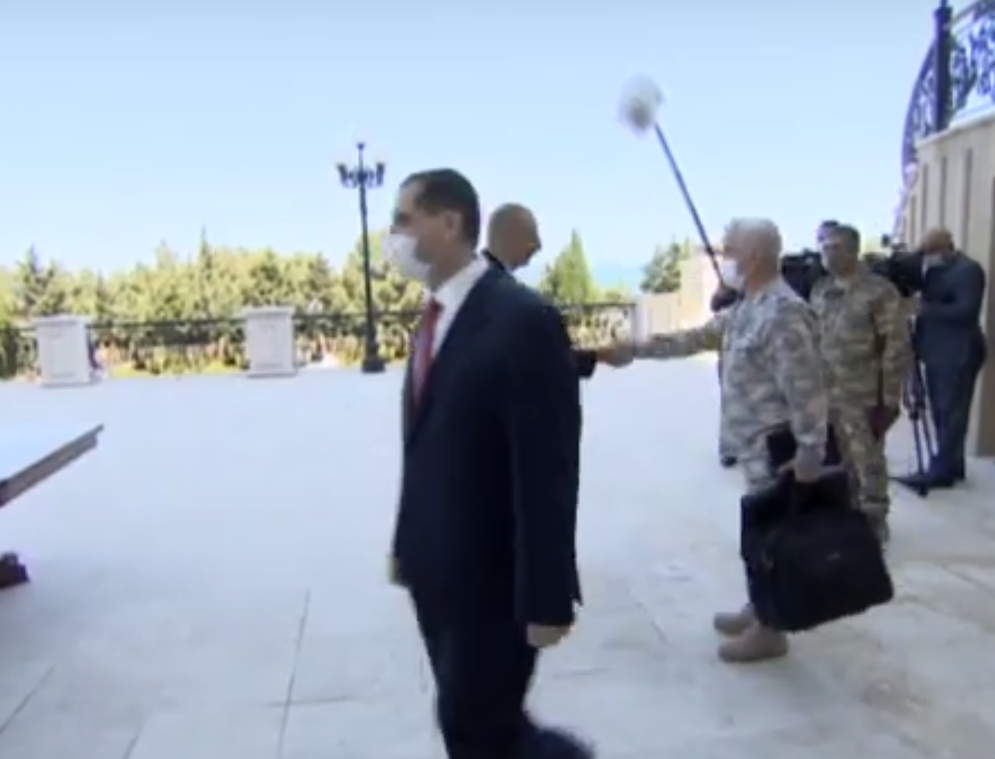
Goksel Kahya at the meeting with the President of Azerbaijan
It is notable that Kahya was present at the meeting of the Turkish Foreign and Defense Ministers with the President of Azerbaijan in Baku on 8 November, as well as at the meeting of the delegation led by the Turkish Defense Minister with the President of Azerbaijan on 31 December. Kahya appeared in these two meetings again “prepared”.
Second fact: after the war, at the end of December, an event was organized during the visit of the Turkish Ministry of Defense delegation to Azerbaijan, where the Defense ministers of Turkey and Azerbaijan took the stage. There is a colonel of the UAV Command of the Turkish Armed Forces sitting among the officers, and Bayraktar TB2 can be seen on his patch.

Officer of the UAV Command of the Turkish Armed Forces in Azerbaijan